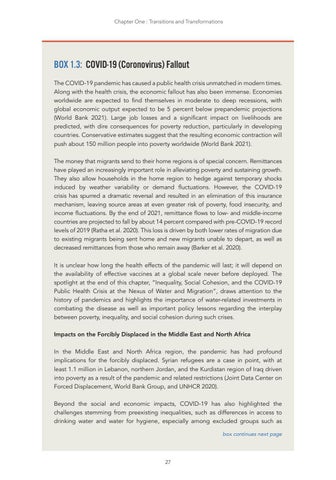Chapter One : Transitions and Transformations
BOX 1.3: COVID-19 (Coronovirus) Fallout The COVID-19 pandemic has caused a public health crisis unmatched in modern times. Along with the health crisis, the economic fallout has also been immense. Economies worldwide are expected to find themselves in moderate to deep recessions, with global economic output expected to be 5 percent below prepandemic projections (World Bank 2021). Large job losses and a significant impact on livelihoods are predicted, with dire consequences for poverty reduction, particularly in developing countries. Conservative estimates suggest that the resulting economic contraction will push about 150 million people into poverty worldwide (World Bank 2021). The money that migrants send to their home regions is of special concern. Remittances have played an increasingly important role in alleviating poverty and sustaining growth. They also allow households in the home region to hedge against temporary shocks induced by weather variability or demand fluctuations. However, the COVID-19 crisis has spurred a dramatic reversal and resulted in an elimination of this insurance mechanism, leaving source areas at even greater risk of poverty, food insecurity, and income fluctuations. By the end of 2021, remittance flows to low- and middle-income countries are projected to fall by about 14 percent compared with pre-COVID-19 record levels of 2019 (Ratha et al. 2020). This loss is driven by both lower rates of migration due to existing migrants being sent home and new migrants unable to depart, as well as decreased remittances from those who remain away (Barker et al. 2020). It is unclear how long the health effects of the pandemic will last; it will depend on the availability of effective vaccines at a global scale never before deployed. The spotlight at the end of this chapter, “Inequality, Social Cohesion, and the COVID-19 Public Health Crisis at the Nexus of Water and Migration”, draws attention to the history of pandemics and highlights the importance of water-related investments in combating the disease as well as important policy lessons regarding the interplay between poverty, inequality, and social cohesion during such crises. Impacts on the Forcibly Displaced in the Middle East and North Africa In the Middle East and North Africa region, the pandemic has had profound implications for the forcibly displaced. Syrian refugees are a case in point, with at least 1.1 million in Lebanon, northern Jordan, and the Kurdistan region of Iraq driven into poverty as a result of the pandemic and related restrictions (Joint Data Center on Forced Displacement, World Bank Group, and UNHCR 2020). Beyond the social and economic impacts, COVID-19 has also highlighted the challenges stemming from preexisting inequalities, such as differences in access to drinking water and water for hygiene, especially among excluded groups such as box continues next page
27



